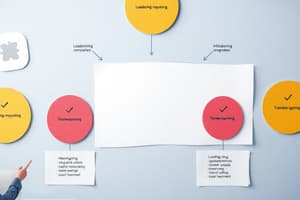Podcast
Questions and Answers
What is Cliff Robinson's primary focus in his role as chief people officer at Chick-fil-A?
What is Cliff Robinson's primary focus in his role as chief people officer at Chick-fil-A?
- Managing daily business operations
- Selecting and coaching high-potential leaders (correct)
- Overseeing financial audits and compliance
- Increasing revenue through aggressive marketing
What significant realization did Cliff Robinson have regarding his leadership approach?
What significant realization did Cliff Robinson have regarding his leadership approach?
- He needed to increase his number of meetings
- He should become more reactive to business needs
- He should avoid delegating responsibilities to his team
- He required a clean slate to focus on quality over quantity (correct)
Which mindset shift did Cliff Robinson make as part of his leadership transformation?
Which mindset shift did Cliff Robinson make as part of his leadership transformation?
- From strategic to reactive leader
- From overinvolved to strategic leader (correct)
- From task-oriented to process-oriented
- From leader-influencer to authoritarian
What was a major factor contributing to Chick-fil-A's year-over-year growth?
What was a major factor contributing to Chick-fil-A's year-over-year growth?
What does Cliff Robinson recognize as his greatest resource that requires careful management?
What does Cliff Robinson recognize as his greatest resource that requires careful management?
What is a primary benefit of using a one-page personal business plan?
What is a primary benefit of using a one-page personal business plan?
How does Adam Grant prioritize his commitments?
How does Adam Grant prioritize his commitments?
What is the main challenge associated with delegation that leaders face?
What is the main challenge associated with delegation that leaders face?
What mindset is suggested as necessary for leaders to enhance their effectiveness?
What mindset is suggested as necessary for leaders to enhance their effectiveness?
What is highlighted as a necessary action for leaders to progress in their roles?
What is highlighted as a necessary action for leaders to progress in their roles?
What is a crucial step leaders should take to clarify their role within the organization?
What is a crucial step leaders should take to clarify their role within the organization?
How can leaders ensure they align their work with the needs of the business?
How can leaders ensure they align their work with the needs of the business?
What should leaders do to prepare for future demands of their business?
What should leaders do to prepare for future demands of their business?
What is the significance of tracking time for leaders?
What is the significance of tracking time for leaders?
What can happen if leaders do not evolve with their business?
What can happen if leaders do not evolve with their business?
What should leaders focus on to balance current responsibilities with future goals?
What should leaders focus on to balance current responsibilities with future goals?
What is an effective method to evaluate whether activities are worth pursuing?
What is an effective method to evaluate whether activities are worth pursuing?
What is a key benefit of tracking your time in fifteen-minute increments?
What is a key benefit of tracking your time in fifteen-minute increments?
When assessing your role, what format is recommended to gather feedback?
When assessing your role, what format is recommended to gather feedback?
Why is it important to revisit time tracking regularly?
Why is it important to revisit time tracking regularly?
What is the primary purpose of creating a one-page business plan?
What is the primary purpose of creating a one-page business plan?
What should you examine when identifying how much of your time is intentional versus reactive?
What should you examine when identifying how much of your time is intentional versus reactive?
Which activity is suggested to mainly fuel personal development and effectiveness?
Which activity is suggested to mainly fuel personal development and effectiveness?
How can you ensure you are focusing on high-payoff activities?
How can you ensure you are focusing on high-payoff activities?
What is recommended for executive leaders like Tim Tassopoulos for personal development?
What is recommended for executive leaders like Tim Tassopoulos for personal development?
What can help leaders become more effective in their roles?
What can help leaders become more effective in their roles?
Which of the following is NOT a suggested step for assessing time and roles?
Which of the following is NOT a suggested step for assessing time and roles?
Flashcards
One-Page Personal Business Plan
One-Page Personal Business Plan
A concise document used to prioritize key tasks and manage executive functions.
Defining Your Role
Defining Your Role
Identifying the activities that add the most value to an organization and align with business needs, skills, and personal enjoyment.
Managing the Decision
Managing the Decision
Deciding on priorities/approaches in advance to avoid repetitive decision-making.
High-Payoff Activities
High-Payoff Activities
Signup and view all the flashcards
Delegation
Delegation
Signup and view all the flashcards
Hourly Wage Filter
Hourly Wage Filter
Signup and view all the flashcards
Time Tracking
Time Tracking
Signup and view all the flashcards
Saying 'No'
Saying 'No'
Signup and view all the flashcards
Developing People
Developing People
Signup and view all the flashcards
Current Reality
Current Reality
Signup and view all the flashcards
Superhero Complex
Superhero Complex
Signup and view all the flashcards
Future Focus
Future Focus
Signup and view all the flashcards
Role Evolution
Role Evolution
Signup and view all the flashcards
Role & Leadership Effectiveness
Role & Leadership Effectiveness
Signup and view all the flashcards
Leadership Potential
Leadership Potential
Signup and view all the flashcards
Leadership Development
Leadership Development
Signup and view all the flashcards
Current Reality
Current Reality
Signup and view all the flashcards
Vision
Vision
Signup and view all the flashcards
Scope, Pace, and Complexity
Scope, Pace, and Complexity
Signup and view all the flashcards
Sustainable Role
Sustainable Role
Signup and view all the flashcards
Strategic Leader
Strategic Leader
Signup and view all the flashcards
Leader-Influencer
Leader-Influencer
Signup and view all the flashcards
Delegation
Delegation
Signup and view all the flashcards
Coaching
Coaching
Signup and view all the flashcards
Empowerment
Empowerment
Signup and view all the flashcards
Double-digit Growth
Double-digit Growth
Signup and view all the flashcards
Clean Slate
Clean Slate
Signup and view all the flashcards
Time Management
Time Management
Signup and view all the flashcards
Scarcest Resource
Scarcest Resource
Signup and view all the flashcards
Weekly Time Allocation
Weekly Time Allocation
Signup and view all the flashcards
Intentional vs. Reactive Work
Intentional vs. Reactive Work
Signup and view all the flashcards
Fifteen-Minute Increments
Fifteen-Minute Increments
Signup and view all the flashcards
Delegation
Delegation
Signup and view all the flashcards
Hourly Wage Filter
Hourly Wage Filter
Signup and view all the flashcards
Stewardship Question
Stewardship Question
Signup and view all the flashcards
One-Page Business Plan
One-Page Business Plan
Signup and view all the flashcards
Keep, Start, Stop
Keep, Start, Stop
Signup and view all the flashcards
High-Payoff Activities
High-Payoff Activities
Signup and view all the flashcards
Role Evolution
Role Evolution
Signup and view all the flashcards
Strategic Bets
Strategic Bets
Signup and view all the flashcards
"Library Days"
"Library Days"
Signup and view all the flashcards
Study Notes
Defining Your Role
- Leadership Development Focus: Chick-fil-A's EVP and CPO prioritizes developing future leaders.
- Balancing Current Reality and Vision: Leaders must maintain present-day responsibilities while developing future skills.
- Prioritization: Time is the most critical resource; leaders must identify high-value activities.
- Alignment: Leaders should align organizational needs, skills, and personal interests for optimal leadership.
- Future-Focused Evolution: Business growth requires leaders to evolve and adapt to new demands.
- Developing Self and Team: Leaders must invest in personal and team development to prepare for the future.
- Maintaining Current Reality: Leaders must manage and run the business while simultaneously developing skills for the future.
- Examples: The author's experience and examples (e.g. Adam Grant, Tim Tassopoulos) highlight the importance of role definition and self-improvement
Seeing Your Role
- High-Payoff Activities: Identifying core responsibilities that deliver the most value determines a leader's role.
- Hourly Wage Filter: Determining hourly wage based on annual compensation allows assessment to determine if tasks are worth that price.
- Time Tracking: For a week, track time in 15-minute increments to assess allocated time and identify wasted time, and identify reactive vs intentional use of time.
- Delegation: Focus on the activities that only you should do/have direct responsibility for, delegate the rest.
- External Perspective: Seek feedback from team members and other trusted sources. (keep, start, stop format).
- Strategic Vision and Bets: Review a leader’s vision and high-value projects for role-relevant opportunities for development.
- One-Page Business Plan: Creating a one-page summary of responsibilities, disciplines, and projects is a useful tool.
Your Role and Leadership Effectiveness
- Prioritization and Effectiveness: Focus on role definition to improve decisions and leadership effectiveness.
- Saying No: Effective leaders learn to say no to activities that do not align with their highest contribution areas; often by delegating the tasks to others.
- Managing the Decision: Leaders can pre-define their priorities and make decisions at a high level, reducing the need to evaluate each request individually.
- Delegation as Growth: Delegation supports growth through empowerment
- Delegating/Supporting: This involves letting go of ego and encouraging others to develop.
- Team Development: Equipping others to innovate and solve problems is leadership's true measure; leadership is about multiplication, not addition
- Avoidance of Complacency: Leaders should continuously evolve, and avoid complacency and defensiveness.
- Cost of Decisions: Careful consideration of the potential effects on others and existing priorities before saying yes to new items will preserve overall effectiveness.
- Delivering "Kind Noes": Effectively saying 'no' is vital for efficient time management. This requires clear communication.
Studying That Suits You
Use AI to generate personalized quizzes and flashcards to suit your learning preferences.
Description
This quiz focuses on the key strategies for leadership development emphasized by Chick-fil-A's EVP and CPO. Topics include balancing current responsibilities with future skills, the importance of prioritization, and aligning personal interests with organizational needs. Learn how leaders can evolve and invest in their own development and that of their teams.




